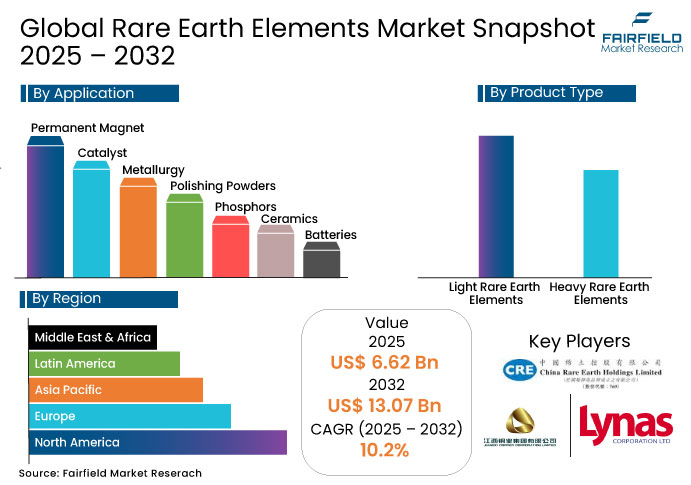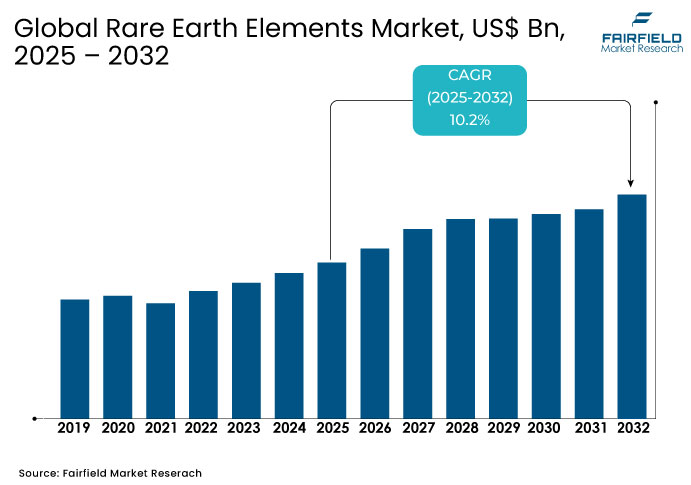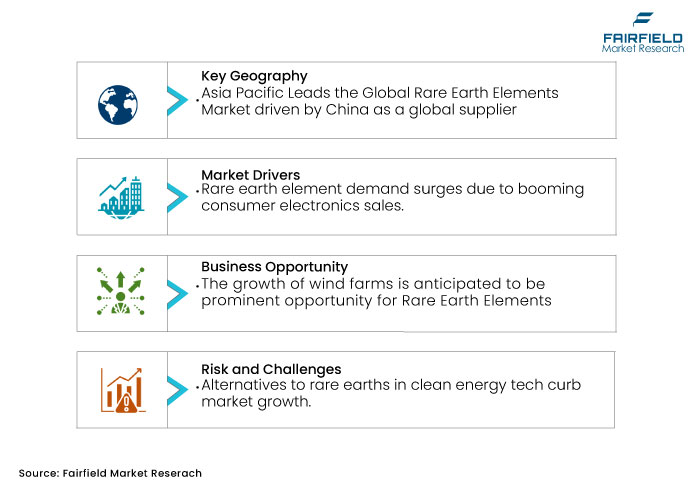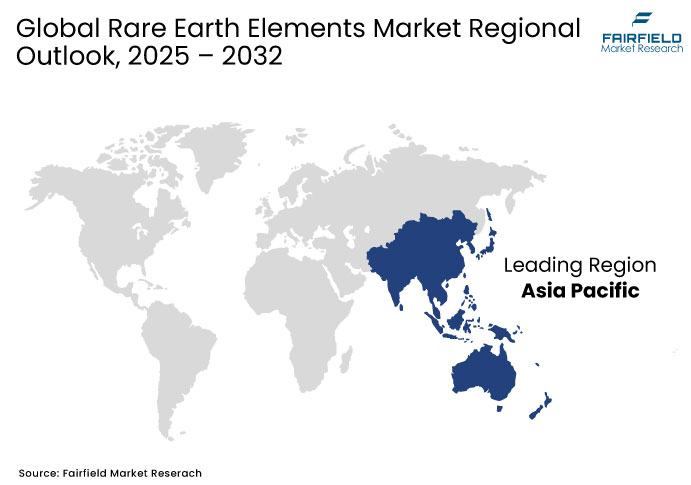Global Rare Earth Elements Market Forecast
- The global Rare Earth Elements (REE) Market size is set to expand at a CAGR of 10.2% and expected to increase from US$ 6.62 Billion in 2025 to reach US$ 13.07 Billion by the end of 2032.
- The demand for rare earth elements is experiencing a surge driven by the increasing popularity of consumer durables such as laptops and smartphones. This trend leads China to dominated the market with around 85% of global sales of refined rare earth elements.

Rare Earth Elements Market Insights
- The REE market is witnessing an increase in involvement in the electric vehicle (EV) sector, with many companies securing long-term agreements to supply materials for EV motor production
- The growth of wind farms will remain the mainstay to drive demand for light as well as heavy rare earth elements such as neodymium, praseodymium, and dysprosium used in wind turbine motors.
- Automotive electrification and decarbonization along with shift towards renewable energy sources has been key technological trends in Asia Pacific region.
- The adoption of magneto-calorific technology in refrigeration systems is growing rapidly due to its high energy efficiency, environmental friendliness, and ability to operate without harmful refrigerants, making it a sustainable alternative to conventional refrigeration technologies.
- State-backed investment in both technology and infrastructure has given Chinese companies an upper hand in the market. These companies largely control the prices, making it challenging for other regions to compete.
A Look Back and a Look Forward - Comparative Analysis
The global rare earth element (REE) market was valued at US$ 4.06 billion in 2019, and it is expected to grow significantly, with a CAGR of 8.5% by 2024. The surge in demand for electronic products, particularly during and after the pandemic, has driven global market growth. China, in particular, has benefited greatly from this post-pandemic demand.
From 2025 to 2032, the rare earth elements market is projected to experience steady growth, with a CAGR of 10.2%. The increasing use of REEs in the clean energy sector is expected to create significant opportunities for market expansion. Furthermore, the rising popularity of electronic and hybrid vehicles in developed regions, driven by environmental concerns and higher per capita income, will sustain demand for rare earth metals in vehicle manufacturing.
Key Growth Determinants
Rising market of EV is thriving demand for REE
The global electric vehicle (EV) market is experiencing significant growth, which is driving demand for materials used in EV manufacturing, particularly rare earth elements. Each EV motor requires approximately 2 to 4 kg of permanent magnets made from rare earth elements.
The expansion of EV infrastructure in both developed and developing countries, combined with increasing government support and initiatives, is fueling the global EV market as part of efforts to decarbonize the automotive industry. For example, in 2023, global electric car sales reached 14 million units, reflecting a 35% increase from 2022. As a result, the global rare earth elements market is poised for growth alongside the evolution of the EV industry.

Key Growth Barriers
Ongoing Investment in Alternatives to Rare Earth Elements, Especially in Clean Energy Technologies
In recent years, there has been increasing momentum in the search for substitutes for rare earth elements. Automakers, lighting companies, and clean tech developers are working to reduce their dependence on the limited and unreliable supply of these materials.
The global reliance on China for rare earth element supplies, particularly for neodymium, praseodymium, dysprosium, and terbium, remains a critical concern. China has previously imposed strict export quotas, triggering panic in downstream industries worldwide.
These events have prompted companies to explore alternative materials or the recycling of rare earth elements. Western economies, heavily dependent on China for raw materials, are particularly concerned about limited supply, soaring prices, and the environmental impact of rare earth extraction, all of which could hinder their decarbonization efforts.
Companies like MAHLE are developing magnet-free motors, which not only offer environmental benefits but also provide cost advantages and enhance resource security. Such innovations could impact the growth of rare earth magnets used in electric vehicles.
Rare Earth Elements Market Trends and Opportunities
Development in clean energy sector with the involvement of rare earth elements.
Rare earth elements play a critical role in advancing clean energy technologies such as wind turbines, electric vehicles, and solar panels. The efficiency gains in wind turbines, driven by permanent magnets, are expected to support a CAGR of over 50% in wind turbine installations. By 2030, the cumulative energy capacity is projected to reach 228 GW, highlighting the significant contribution of rare earth elements in expanding sustainable energy solutions and shaping the future of global energy sustainability.
Neodymium, dysprosium, praseodymium, and terbium are essential for producing powerful permanent magnets used in wind turbine generators. Each wind turbine may require 1-2 tons of Neodymium-Iron-Boron magnets per megawatt due to their exceptional strength, with the ability to exert forces up to 1,000 times their weight. This drives the increasing demand for rare earth elements.
Addressing REE Shortages through Comprehensive Recycling Solutions
Recent research has explored innovative, albeit costly, recycling methods for rare earth elements (REEs). The Critical Materials Institute in the U.S. has proposed a technique using copper salts to recover 90-98% of REEs from discarded magnets, producing pure metals that can be used to manufacture new magnets. This method offers a significantly lower carbon footprint compared to traditional mining and processing methods.
Additionally, recycling neodymium from U.S. hard-disk drives has emerged as a promising solution. This approach could potentially fulfill around 5% of the global neodymium demand within a few years. These advancements in recycling technologies present a sustainable alternative to traditional mining, helping to meet the rising demand for rare earth metals.

Leading Segment Overview
Huge Demand for Neodymium in Permanent Magnets Production
In 2025, the global neodymium market is valued over US$ 3.50 billion, with a forecasted CAGR of 10.7% by 2032. Neodymium and praseodymium are essential to the rare earth elements market, particularly for their crucial role in producing permanent magnets used across various industries, including industrial applications, consumer goods, renewable energy, and robotics.
Neodymium, in particular, is a key element in rare earth minerals, known for its significant contribution to high-performance magnets. Its high melting point makes it ideal for applications in high-temperature environments, such as electric motors. When combined with iron and boron, it forms neodymium-iron-boron magnets, which are the strongest permanent magnets available. These magnets have driven innovation across industries and technologies, fueling advancements in electric vehicles, wind turbines, and more.
Growing Demand for Cerium in Catalysis Process
The global cerium market, valued at US$ 185 million in 2025, is projected to grow at a CAGR of 3.8% by 2032. Cerium plays a vital role in reducing emissions from internal combustion vehicles and improving catalyst purification rates. Cerium oxide is used in steam and dry methane reforming for syngas production, and its combination with noble metals or other oxides enhances oxidation and hydrogenation processes.
Furthermore, cerium's demand is rising due to its various applications in fluidized cracking catalysis within oil and petroleum refineries, where cerium oxide boosts catalyst activity and prevents the loss of acid sites during catalysis. It is also used as a polishing compound for glass and electronics. The increasing enforcement of stringent pollution regulations worldwide further drives the market's growth.
Regional Analysis
- Defense Applications Power Rare Earth Elements Market Growth Across North America
The North American rare earth element (REE) market is primarily driven by the United States, where MP Materials operates the only REE mine, holding around 2.3 million metric tons of proven reserves. Despite this significant reserve, the U.S. remains heavily dependent on imports, with approximately 78% of REEs sourced from China. In 2023, U.S. imports of REEs reached about $200 million, fueled by rising demand from the electronics and electric vehicle sectors.
In addition, the renewable energy and defense sectors are key drivers of REE demand. These elements are essential for advancing technologies in both fields. For example, each F-35 stealth fighter aircraft manufactured by Lockheed Martin requires approximately 400 kg of rare earth elements for its electronic warfare systems. As global orders for advanced defense equipment increase, the demand for REEs is expected to grow, particularly from the defense sector in the U.S.

- Europe's High Dependence on Imports Drives the Expansion of Market Alternatives
The European rare earth elements market is experiencing steady growth, driven by increasing demand from the renewable energy, automotive, and defense sectors. Europe is highly reliant on imports for its REE supply, with China being the primary supplier. To reduce this dependency, the European Union is investing in the development of domestic REE production capabilities, including recycling initiatives and exploration of new mining projects.
In particular, the EV market is a significant driver of REE demand, as elements like neodymium and dysprosium are crucial for EV motors and batteries. The renewable energy sector, particularly wind power, also contributes to the demand, as rare earth magnets are essential for wind turbine generators. Furthermore, Europe’s defense industry requires REEs for advanced technology and electronic systems. As Europe works toward enhancing its supply chain resilience and meeting green energy goals, the REE market is expected to expand significantly in the coming years.
- Asia Pacific Leads the Global Rare Earth Elements Market
The Asia Pacific rare earth element market is the largest globally, primarily driven by China, which dominates both production and supply of REEs. China controls a significant portion of the world’s rare earth reserves and remains the leading exporter, with countries across the region heavily reliant on its supply. However, several nations, including Japan, South Korea, and India, are seeking to reduce dependence on Chinese imports by diversifying their sources and investing in domestic production and recycling technologies.
The demand for REEs in Asia Pacific is largely fueled by the rapidly growing EV industry, renewable energy projects, and electronics manufacturing. Neodymium and dysprosium, for example, are essential for the production of high-performance magnets used in EV motors and wind turbines. Additionally, the defense sector in countries like India and Japan is increasingly dependent on REEs for advanced technologies. With continued industrialization and green energy initiatives, the region’s REE market is poised for significant growth.
Competitive Landscape
The global rare earth elements market is largely dominated by China-based firms, prompting top players to innovate new extraction techniques with reduced carbon footprints. These initiatives aim to mitigate environmental impact and address sustainability concerns associated with rare earth element extraction. Moreover, manufacturers are exploring environmentally sustainable recycling methods to minimize waste and reliance on virgin materials, thus promoting circular economy principles.
For instance, Noveon Magnetics in San Marcos, Texas, pioneer in producing recycled neodymium magnets without the need for rare earth extraction. This approach achieves over 99% recycling, cutting energy use by approximately 90%, and reducing carbon dioxide emissions by half compared to traditional manufacturing methods.
In March 2024, Australian Strategic Materials (ASM) has appointed global engineering company Bechtel Mining and Metals to conduct Front-End Engineering Design services for rare earth elements in the Dubbo Project in New South Wales
Key Companies
- Lynas Rare Earth Ltd.
- China Rare Earth Holding Ltd.
- Jiangxi Copper Co. Ltd.
- China Minmetals Rare Earth Co. Ltd.
- Xiamen Tungsten Co. Ltd.
- Guangdong Rare Earth Industry Grp Co. Ltd.
- Grinm Advanced Materials Co Ltd.
- MP Materials
- Shenghe Resources holding Co. Ltd.
- IREL Ltd.
Global Rare Earth Elements Market Segmentation-
By Product Type
- Light Rare Earth Elements
- Lanthanum
- Cerium
- Neodymium
- Samarium
- Praseodymium
- Misc. (Europium, etc.)
- Heavy Rare Earth Elements
- Yttrium
- Dysprosium
- Gadolinium
- Terbium
- Erbium
- Misc. (Holmium, Thulium)
By Application
- Permanent Magnet
- Catalyst
- Metallurgy
- Polishing Powders
- Phosphors
- Ceramics
- Batteries
- Misc. (Glass, Chemical, Defense)
By Region
- North America
- Europe
- Asia Pacific
- Latin America
- The Middle East & Africa
1. Executive Summary
1.1. Global Rare Earth Elements Market Snapshot
1.2. Future Projections
1.3. Key Market Trends
1.4. Regional Snapshot, by Value, 2025
1.5. Analyst Recommendations
2. Market Overview
2.1. Market Definitions and Segmentations
2.2. Market Dynamics
2.2.1. Drivers
2.2.2. Restraints
2.2.3. Market Opportunities
2.3. Value Chain Analysis
2.4. COVID-19 Impact Analysis
2.5. Porter's Fiver Forces Analysis
2.6. Impact of Russia-Ukraine Conflict
2.7. PESTLE Analysis
2.8. Regulatory Analysis
2.9. Price Trend Analysis
2.9.1. Current Prices and Future Projections, 2024-2032
2.9.2. Price Impact Factors
3. Global Rare Earth Elements Market Outlook, 2019 - 2032
3.1. Global Rare Earth Elements Market Outlook, by Product Type, Value (US$ Bn) & Volume (Tons), 2019-2032
3.1.1. Light Rare Earth Elemtns
3.1.1.1. Lanthanum
3.1.1.2. Cerium
3.1.1.3. Neodymium
3.1.1.4. Samarium
3.1.1.5. Praseodymium
3.1.1.6. Misc.
3.1.2. Heavy Rare Earth Elements Market
3.1.2.1. Yttrium
3.1.2.2. Dysprosium
3.1.2.3. Gadolinium
3.1.2.4. Terbium
3.1.2.5. Erbium
3.1.2.6. Misc.
3.2. Global Rare Earth Elements Market Outlook, by Application, Value (US$ Bn) & Volume (Tons), 2019-2032
3.2.1. Permanent Magnet
3.2.2. Catalyst
3.2.3. Metallurgy
3.2.4. Polishing Powders
3.2.5. Phosphors
3.2.6. Ceramics
3.2.7. Batteries
3.2.8. Misc.
3.3. Global Rare Earth Elements Market Outlook, by Region, Value (US$ Bn) & Volume (Tons), 2019-2032
3.3.1. North America
3.3.2. Europe
3.3.3. Asia Pacific
3.3.4. Latin America
3.3.5. Middle East & Africa
4. North America Rare Earth Elements Market Outlook, 2019 - 2032
4.1. North America Rare Earth Elements Market Outlook, by Product Type, Value (US$ Bn) & Volume (Tons), 2019-2032
4.1.1. Light Rare Earth Elemtns
4.1.1.1. Lanthanum
4.1.1.2. Cerium
4.1.1.3. Neodymium
4.1.1.4. Samarium
4.1.1.5. Praseodymium
4.1.1.6. Misc.
4.1.2. Heavy Rare Earth Elements Market
4.1.2.1. Yttrium
4.1.2.2. Dysprosium
4.1.2.3. Gadolinium
4.1.2.4. Terbium
4.1.2.5. Erbium
4.1.2.6. Misc.
4.2. North America Rare Earth Elements Market Outlook, by Application, Value (US$ Bn) & Volume (Tons), 2019-2032
4.2.1. Permanent Magnet
4.2.2. Catalyst
4.2.3. Metallurgy
4.2.4. Polishing Powders
4.2.5. Phosphors
4.2.6. Ceramics
4.2.7. Batteries
4.2.8. Misc.
4.3. North America Rare Earth Elements Market Outlook, by Country, Value (US$ Bn) & Volume (Tons), 2019-2032
4.3.1. U.S. Rare Earth Elements Market Outlook, by Product Type, 2019-2032
4.3.2. U.S. Rare Earth Elements Market Outlook, by Application, 2019-2032
4.3.3. Canada Rare Earth Elements Market Outlook, by Product Type, 2019-2032
4.3.4. Canada Rare Earth Elements Market Outlook, by Application, 2019-2032
4.4. BPS Analysis/Market Attractiveness Analysis
5. Europe Rare Earth Elements Market Outlook, 2019 - 2032
5.1. Europe Rare Earth Elements Market Outlook, by Product Type, Value (US$ Bn) & Volume (Tons), 2019-2032
5.1.1. Light Rare Earth Elemtns
5.1.1.1. Lanthanum
5.1.1.2. Cerium
5.1.1.3. Neodymium
5.1.1.4. Samarium
5.1.1.5. Praseodymium
5.1.1.6. Misc.
5.1.2. Heavy Rare Earth Elements Market
5.1.2.1. Yttrium
5.1.2.2. Dysprosium
5.1.2.3. Gadolinium
5.1.2.4. Terbium
5.1.2.5. Erbium
5.1.2.6. Misc.
5.2. Europe Rare Earth Elements Market Outlook, by Application, Value (US$ Bn) & Volume (Tons), 2019-2032
5.2.1. Permanent Magnet
5.2.2. Catalyst
5.2.3. Metallurgy
5.2.4. Polishing Powders
5.2.5. Phosphors
5.2.6. Ceramics
5.2.7. Batteries
5.2.8. Misc.
5.3. Europe Rare Earth Elements Market Outlook, by Country, Value (US$ Bn) & Volume (Tons), 2019-2032
5.3.1. Germany Rare Earth Elements Market Outlook, by Product Type, 2019-2032
5.3.2. Germany Rare Earth Elements Market Outlook, by Application, 2019-2032
5.3.3. Italy Rare Earth Elements Market Outlook, by Product Type, 2019-2032
5.3.4. Italy Rare Earth Elements Market Outlook, by Application, 2019-2032
5.3.5. France Rare Earth Elements Market Outlook, by Product Type, 2019-2032
5.3.6. France Rare Earth Elements Market Outlook, by Application, 2019-2032
5.3.7. U.K. Rare Earth Elements Market Outlook, by Product Type, 2019-2032
5.3.8. U.K. Rare Earth Elements Market Outlook, by Application, 2019-2032
5.3.9. Spain Rare Earth Elements Market Outlook, by Product Type, 2019-2032
5.3.10. Spain Rare Earth Elements Market Outlook, by Application, 2019-2032
5.3.11. Russia Rare Earth Elements Market Outlook, by Product Type, 2019-2032
5.3.12. Russia Rare Earth Elements Market Outlook, by Application, 2019-2032
5.3.13. Rest of Europe Rare Earth Elements Market Outlook, by Product Type, 2019-2032
5.3.14. Rest of Europe Rare Earth Elements Market Outlook, by Application, 2019-2032
5.4. BPS Analysis/Market Attractiveness Analysis
6. Asia Pacific Rare Earth Elements Market Outlook, 2019 - 2032
6.1. Asia Pacific Rare Earth Elements Market Outlook, by Product Type, Value (US$ Bn) & Volume (Tons), 2019-2032
6.1.1. Light Rare Earth Elemtns
6.1.1.1. Lanthanum
6.1.1.2. Cerium
6.1.1.3. Neodymium
6.1.1.4. Samarium
6.1.1.5. Praseodymium
6.1.1.6. Misc.
6.1.2. Heavy Rare Earth Elements Market
6.1.2.1. Yttrium
6.1.2.2. Dysprosium
6.1.2.3. Gadolinium
6.1.2.4. Terbium
6.1.2.5. Erbium
6.1.2.6. Misc.
6.2. Asia Pacific Rare Earth Elements Market Outlook, by Application, Value (US$ Bn) & Volume (Tons), 2019-2032
6.2.1. Permanent Magnet
6.2.2. Catalyst
6.2.3. Metallurgy
6.2.4. Polishing Powders
6.2.5. Phosphors
6.2.6. Ceramics
6.2.7. Batteries
6.2.8. Misc.
6.3. Asia Pacific Rare Earth Elements Market Outlook, by Country, Value (US$ Bn) & Volume (Tons), 2019-2032
6.3.1. China Rare Earth Elements Market Outlook, by Product Type, 2019-2032
6.3.2. China Rare Earth Elements Market Outlook, by Application, 2019-2032
6.3.3. Japan Rare Earth Elements Market Outlook, by Product Type, 2019-2032
6.3.4. Japan Rare Earth Elements Market Outlook, by Application, 2019-2032
6.3.5. South Korea Rare Earth Elements Market Outlook, by Product Type, 2019-2032
6.3.6. South Korea Rare Earth Elements Market Outlook, by Application, 2019-2032
6.3.7. India Rare Earth Elements Market Outlook, by Product Type, 2019-2032
6.3.8. India Rare Earth Elements Market Outlook, by Application, 2019-2032
6.3.9. Southeast Asia Rare Earth Elements Market Outlook, by Product Type, 2019-2032
6.3.10. Southeast Asia Rare Earth Elements Market Outlook, by Application, 2019-2032
6.3.11. Rest of SAO Rare Earth Elements Market Outlook, by Product Type, 2019-2032
6.3.12. Rest of SAO Rare Earth Elements Market Outlook, by Application, 2019-2032
6.4. BPS Analysis/Market Attractiveness Analysis
7. Latin America Rare Earth Elements Market Outlook, 2019 - 2032
7.1. Latin America Rare Earth Elements Market Outlook, by Product Type, Value (US$ Bn) & Volume (Tons), 2019-2032
7.1.1. Light Rare Earth Elemtns
7.1.1.1. Lanthanum
7.1.1.2. Cerium
7.1.1.3. Neodymium
7.1.1.4. Samarium
7.1.1.5. Praseodymium
7.1.1.6. Misc.
7.1.2. Heavy Rare Earth Elements Market
7.1.2.1. Yttrium
7.1.2.2. Dysprosium
7.1.2.3. Gadolinium
7.1.2.4. Terbium
7.1.2.5. Erbium
7.1.2.6. Misc.
7.2. Latin America Rare Earth Elements Market Outlook, by Application, Value (US$ Bn) & Volume (Tons), 2019-2032
7.2.1. Permanent Magnet
7.2.2. Catalyst
7.2.3. Metallurgy
7.2.4. Polishing Powders
7.2.5. Phosphors
7.2.6. Ceramics
7.2.7. Batteries
7.2.8. Misc.
7.3. Latin America Rare Earth Elements Market Outlook, by Country, Value (US$ Bn) & Volume (Tons), 2019-2032
7.3.1. Brazil Rare Earth Elements Market Outlook, by Product Type, 2019-2032
7.3.2. Brazil Rare Earth Elements Market Outlook, by Application, 2019-2032
7.3.3. Mexico Rare Earth Elements Market Outlook, by Product Type, 2019-2032
7.3.4. Mexico Rare Earth Elements Market Outlook, by Application, 2019-2032
7.3.5. Argentina Rare Earth Elements Market Outlook, by Product Type, 2019-2032
7.3.6. Argentina Rare Earth Elements Market Outlook, by Application, 2019-2032
7.3.7. Rest of LATAM Rare Earth Elements Market Outlook, by Product Type, 2019-2032
7.3.8. Rest of LATAM Rare Earth Elements Market Outlook, by Application, 2019-2032
7.4. BPS Analysis/Market Attractiveness Analysis
8. Middle East & Africa Rare Earth Elements Market Outlook, 2019 - 2032
8.1. Middle East & Africa Rare Earth Elements Market Outlook, by Product Type, Value (US$ Bn) & Volume (Tons), 2019-2032
8.1.1. Light Rare Earth Elemtns
8.1.1.1. Lanthanum
8.1.1.2. Cerium
8.1.1.3. Neodymium
8.1.1.4. Samarium
8.1.1.5. Praseodymium
8.1.1.6. Misc.
8.1.2. Heavy Rare Earth Elements Market
8.1.2.1. Yttrium
8.1.2.2. Dysprosium
8.1.2.3. Gadolinium
8.1.2.4. Terbium
8.1.2.5. Erbium
8.1.2.6. Misc.
8.2. Middle East & Africa Rare Earth Elements Market Outlook, by Application, Value (US$ Bn) & Volume (Tons), 2019-2032
8.2.1. Permanent Magnet
8.2.2. Catalyst
8.2.3. Metallurgy
8.2.4. Polishing Powders
8.2.5. Phosphors
8.2.6. Ceramics
8.2.7. Batteries
8.2.8. Misc.
8.3. Middle East & Africa Rare Earth Elements Market Outlook, by Country, Value (US$ Bn) & Volume (Tons), 2019-2032
8.3.1. GCC Rare Earth Elements Market Outlook, by Product Type, 2019-2032
8.3.2. GCC Rare Earth Elements Market Outlook, by Application, 2019-2032
8.3.3. South Africa Rare Earth Elements Market Outlook, by Product Type, 2019-2032
8.3.4. South Africa Rare Earth Elements Market Outlook, by Application, 2019-2032
8.3.5. Egypt Rare Earth Elements Market Outlook, by Product Type, 2019-2032
8.3.6. Egypt Rare Earth Elements Market Outlook, by Application, 2019-2032
8.3.7. Nigeria Rare Earth Elements Market Outlook, by Product Type, 2019-2032
8.3.8. Nigeria Rare Earth Elements Market Outlook, by Application, 2019-2032
8.3.9. Rest of Middle East Rare Earth Elements Market Outlook, by Product Type, 2019-2032
8.3.10. Rest of Middle East Rare Earth Elements Market Outlook, by Application, 2019-2032
8.4. BPS Analysis/Market Attractiveness Analysis
9. Competitive Landscape
9.1. Company Vs Segment Heatmap
9.2. Company Market Share Analysis, 2024
9.3. Competitive Dashboard
9.4. Company Profiles
9.4.1. Lynas Rare Earth Ltd.
9.4.1.1. Company Overview
9.4.1.2. Product Portfolio
9.4.1.3. Financial Overview
9.4.1.4. Business Strategies and Developments
9.4.2. China Rare Earth Holding Ltd.
9.4.2.1. Company Overview
9.4.2.2. Product Portfolio
9.4.2.3. Financial Overview
9.4.2.4. Business Strategies and Developments
9.4.3. Jiangxi Copper Co. Ltd.
9.4.3.1. Company Overview
9.4.3.2. Product Portfolio
9.4.3.3. Financial Overview
9.4.3.4. Business Strategies and Developments
9.4.4. China Minmetals Rare Earth Co. Ltd.
9.4.4.1. Company Overview
9.4.4.2. Product Portfolio
9.4.4.3. Financial Overview
9.4.4.4. Business Strategies and Developments
9.4.5. Xiamen Tungsten Co. Ltd.
9.4.5.1. Company Overview
9.4.5.2. Product Portfolio
9.4.5.3. Financial Overview
9.4.5.4. Business Strategies and Developments
9.4.6. Guangdong Rare Earth Industry Grp Co. Ltd.
9.4.6.1. Company Overview
9.4.6.2. Product Portfolio
9.4.6.3. Financial Overview
9.4.6.4. Business Strategies and Developments
9.4.7. Grinm Advanced Materials Co Ltd.
9.4.7.1. Company Overview
9.4.7.2. Product Portfolio
9.4.7.3. Financial Overview
9.4.7.4. Business Strategies and Developments
9.4.8. MP Materials
9.4.8.1. Company Overview
9.4.8.2. Product Portfolio
9.4.8.3. Financial Overview
9.4.8.4. Business Strategies and Developments
9.4.9. Shenghe Resources holding Co. Ltd.
9.4.9.1. Company Overview
9.4.9.2. Product Portfolio
9.4.9.3. Financial Overview
9.4.9.4. Business Strategies and Developments
9.4.10. IREL Ltd.
9.4.10.1. Company Overview
9.4.10.2. Product Portfolio
9.4.10.3. Financial Overview
9.4.10.4. Business Strategies and Developments
10. Appendix
10.1. Research Methodology
10.2. Report Assumptions
10.3. Acronyms and Abbreviations
|
BASE YEAR |
HISTORICAL DATA |
FORECAST PERIOD |
UNITS |
|||
|
2024 |
|
2019 - 2024 |
2025 - 2032 |
Value: US$ Billion |
||
|
REPORT FEATURES |
DETAILS |
|
Product Type Coverage |
|
|
Application Coverage |
|
|
Geographical Coverage |
|
|
Leading Companies |
|
|
Report Highlights |
Key Market Indicators, Macro-micro economic impact analysis, Technological Roadmap, Key Trends, Driver, Restraints, and Future Opportunities & Revenue Pockets, Porter’s 5 Forces Analysis, Historical Trend (2019-2024), Market Estimates and Forecast, Market Dynamics, Industry Trends, Competition Landscape, Category, Region, Country-wise Trends & Analysis, COVID-19 Impact Analysis (Demand and Supply Chain) |
